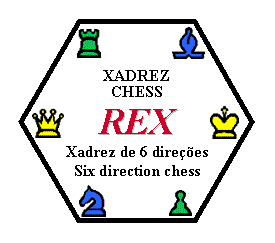
http://www.oocities.org/xadrezrex
Written by Arnaldo Rodrigues D'Almeida
Published in: April / 2002
Revised in: June/2002

4- The game
COMPARISON WITH THE CHESS
There are several differences between REX and chess, however, the essence of the game is the same, in other words, to give checkmate in the opposing King.
The REX board has only one central hexagon (j5) and in the chess board there are 4 squares in the centre. It has 21 hexagons (in chess, squares) more than the chess board. Besides the white and black hexagons, there are grey hexagons.
The pieces in the REX board have larger degree of freedom, in other words, the pieces can move in a more numbers of directions than a traditional chess.
The pieces are the same of the chess. There is similarity of movements of the pieces in the REX board in relation to the movements that those same pieces have in the chess board. In both boards, the King can be moved to all the neighboring hexagons (in REX the hexagons in the diagonal are not neighboring); the Pawn advances 1 hexagon in the direction orthogonal; the Knight can be moved 1 hexagon in the orthogonal direction followed by 1 hexagon in the diagonal direction, or to the opposite, always being moved the largest possible displacement; the Bishop is only moved in the diagonal direction; the Rook is only moved in the orthogonal direction and the Queen can be moved as Bishop or Rook. The Figure 2 of the rules illustrates the movements of the pieces.
Each player begins the game with 24 pieces, 8 pieces (7 Pawns and 1 Bishop) more than chess game. The King is not moved in the diagonal direction.
The Pawns can capture in the same way that they are moved, so they cannot be blocked by the opposing pieces. The block of the Pawns is a situation that happens in a game of traditional chess. The Pawns can't be moved because the square to which they could be moved is occupied by an opposing piece.
There isn't castling. It doesn't make sense because the King is not more protected in the corner and the Rook participate more easily in the game when placed in the corner.
MOVEMENT OF THE PIECES
In the REX, all the pieces capture in the same way that they are moved, in the chess also, except the Pawn that is moved forward in the orthogonal direction and it captures being moved forward in the diagonal direction.
Triangular movement
The REX board has 3 diagonal directions and 3 orthogonal directions, instead of two, and it allows the pieces to be moved in triangles. Triangular movement happens when the piece describes a triangle (Figure 1) in three moves.
Figure 1: Triangular movement.
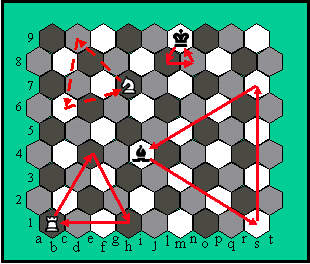
A piece can be moved from one of the vertexes of the triangle to the other, maintaining the attack or the defense on a piece located in the third vertex. The Figure 2 illustrates that idea.
Figure 2: Defense in triangular movement. The Knight is attacked by the Pawn that defends the Bishop that is attacked by the Rook. The Knight can be moved to f5 or p4, getting rid of the attack and maintaining the Bishop's defense.
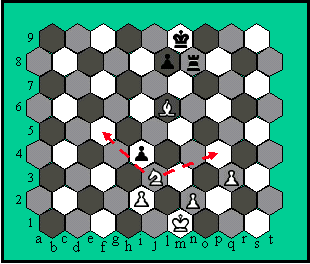
In that same situation in the traditional chess, the player of the white pieces would have to opt between the Bishop or the Knight (Figure 3).
Figure 3: Double attacks. The white's player will have to opt between the Knight and the Bishop.

Zig-zag Moviment
The hexagon where the Pawn is placed and the two hexagons to which it can be moved forward have different colors each of them. The Pawn can be moved only to hexagons of two different colors. Thus, only one Bishop won't be capable to impede the coronation of a Pawn, because it can always be moved to a hexagon of a different color from the one where the Bishop could capture it. To do that, the Pawn has to be moved in zig-zag (Figure 4). The King can also be moved in zig-zag and the Bishop by itself is not capable to impede the King's progress.
Figure 4: Movement of the Pawn in zig-zag.

CHECKMATE BASIC
King and Queen x King
The Queen is capable to give checkmate by itself, without the King's help, due to the King can't be moved in the diagonal (Figure 5).
Figure 5: The Queen gives checkmate.

King and Rook x King
The Rook needs the King's help to give checkmate (Figure 6).
Figure 6: The Rook and King give checkmate.

King and 2 Bishops x King
Two Bishops with the King can give checkmate if they have the opposing King in a hexagon of “corner” (b1, b9, s1 or s9) of the same color to where the Bishops can be moved. For the pair of Bishops “white” and “grey”, the opposing King should be in the “corner” of hexagons of colors white and grey (Figure 7). For the pair of Bishops “black” and “grey”, the opposing King should be in the “corner” of colors black and grey (Figure 8). It is not possible to give checkmate when the opposing King is not in the hexagons of “corner”, unless the opponent collaborates.
Figure 7: Checkmate with King and two Bishops, “grey” and “white”.

Figure 8: Checkmate with King and two Bishops, “grey” and “black”.

Once the opposing King is in the right “corner”, the King should protect the neighboring hexagon, ending the escape possibility. That hexagon is inaccessible to the Bishops because it has a different color from the one where they can be moved, therefore it should be protected by the King.
When one of the Bishops is not “grey”, the player can't give checkmate. The opposing King can be moved to the hexagon of grey color or not. If it is moved to, the Bishops cannot attack. When it is moved to hexagon of a different color from grey, and it is in the “corner”, it will always have the option of moving to the two grey hexagons, and the opponent King is able to protect just one of them. In this situation, the game is considered a tie, for insufficiency of pieces.
King and 2 Knights x King
The player's strategy is to force the opposing King into one of the corners (b1, b9, s1 or s9) where it is possible to give checkmate. Only Knights are capable to give checkmate. However, without help of the King it is not possible to force the opposing King into the corner (Figure 9 and 10).
Figure 9: Checkmate with 2 Knights with the King's help to corner the opposing King.
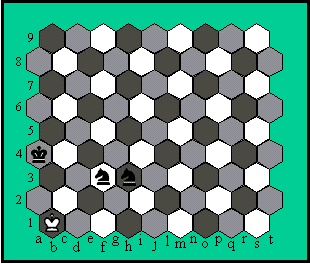
Figure 10: Checkmate with 2 Knights and the King.

King, Bishop and Knight x King
The player's strategy is to force the King into one of the corners (b1, b9, s1 or s9) where it is possible to give checkmate (Figure 11).
Figure 11: Checkmate of King, Bishop and Knight.
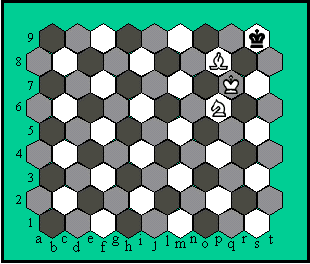
VALUE OF THE PIECES
The pieces have value of importance that is associated to the attack power (and defense) and its characteristics.
The relative value between the pieces is important to guide the player in the moves that involve change of pieces. The material gain many times are advantageous. Of course there are situations when is not true. Typical examples are the “gambits”, when one of the players gains material just to lose the game after some moves.
The Attack Power of a piece, by definition, is the number of hexagons that it can attack in one move. The piece located in the border of the board has less mobility, and consequently less attack power, when this same piece is located in the center. The Attack Power of the piece depends on where it is located in the board. The Attack Power of each piece can be expressed in relation to Pawn's (minor attack power).
The Average Attack Power,
by definition, is a pondered average of the Piece Attack Power in all the
hexagons it can be moved. The pondered average can be calculated by dividing the
total number of hexagons the piece attacks on empty board for the total number
of hexagons it can be moved (Table 1).
Table 1: Average Attack Power of the pieces relative to the Pawn's in the chess and REX empty boards.
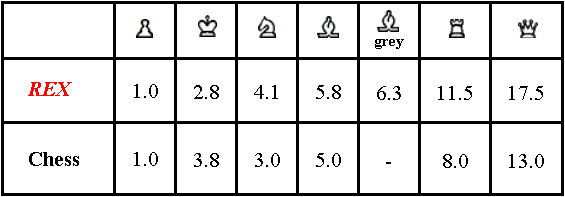
The value of the pieces should not only be based on the Attack Power, because the pieces have others characteristics that are important too. For example, the Knight jumps the pieces, what constitutes in an advantage, however it is not capable to cross the board in one move as the Bishop, the Rook and the Queen are. The Bishop has one disadvantage because it can not be moved to hexagons of different colors from it own. The Pawn is crowned in the last row to become a more powerful piece, for example, the Queen.
The King is certainly the most important piece of the game. If the King is “captured” (checkmate), the game finishes with the opponent's victory, even if you have great material advantage. There is no value that can be attributed to the King.
An estimate of the value of the pieces relatively to the Pawn's, considered good by the inventor of the game, based on the Attack Power and its characteristics, is described in the Table 2.
Table 2: Esteemed value of the pieces in the chess and REX games.
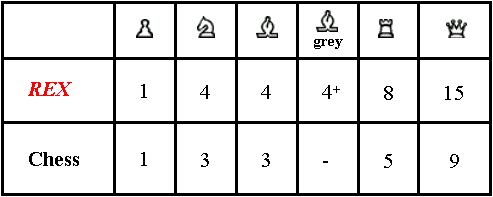
Information or comments send e-mail to: chessrex@bol.com.br

|
1- Introduction |
|
2- Rules |
|
3- Notation |
|
4- The game |
|
5- Strategies |
|
6- Matches |
|
7- Problems |
|
8- Board |
| 9- Downloads |
| 10- Links |